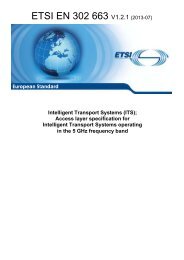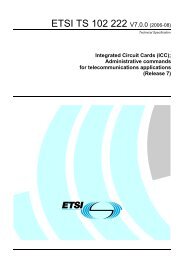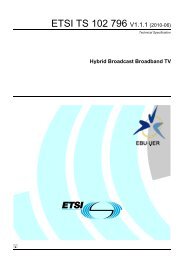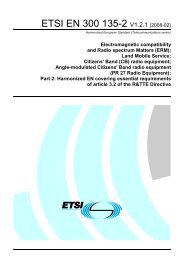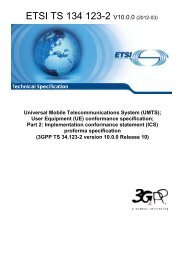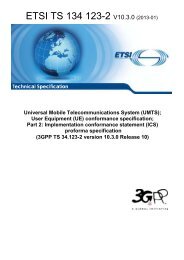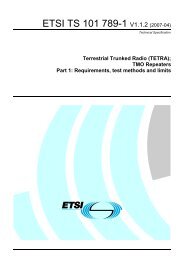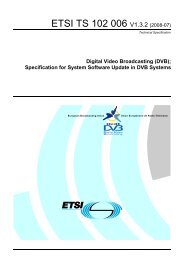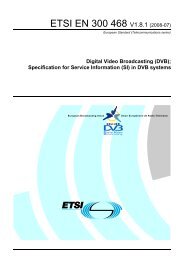TS 102 323 - V1.4.1 - Digital Video Broadcasting (DVB ... - ETSI
TS 102 323 - V1.4.1 - Digital Video Broadcasting (DVB ... - ETSI
TS 102 323 - V1.4.1 - Digital Video Broadcasting (DVB ... - ETSI
You also want an ePaper? Increase the reach of your titles
YUMPU automatically turns print PDFs into web optimized ePapers that Google loves.
6.3 Default authority and abbreviated CRIDs<br />
6.3.1 Abbreviated CRID rules<br />
28<br />
E<strong>TS</strong>I<br />
E<strong>TS</strong>I <strong>TS</strong> <strong>102</strong> <strong>323</strong> <strong>V1.4.1</strong> (2010-01)<br />
In certain situations described in the present document a CRID string may use the following abbreviated forms. These<br />
reduce the overhead of a CRID string by leaving out information that can be inferred from the location of the CRID<br />
entry.<br />
Firstly, the characters "crid://" may be omitted from the start of the string so that the string starts with the first character<br />
of the CRID authority. So the example CRID:<br />
• crid://company.com/foobar<br />
may be encoded as:<br />
• company.com/foobar<br />
Additionally, within the scope of the definition of a default authority (see clause 6.3.2), the CRID authority part of the<br />
string may also be omitted if the CRID's authority matches the current value of default authority. In this case the string<br />
starts with the delimiter between CRID authority and data parts of the CRID (i.e. "/"). Therefore, the example CRID:<br />
• crid://company.com/foobar<br />
may be encoded as:<br />
• /foobar<br />
6.3.2 Scope of a default authority definition<br />
A default authority is defined by the presence of a default authority descriptor. The purpose of the default authority is to<br />
allow a CRID reference within the scope of such a definition to leave out the protocol and authority parts of a CRID<br />
URI, if the CRID authority part of that CRID reference is the same as the defined default authority.<br />
The scope of a particular value of default authority is defined by the location of the default authority descriptor. A value<br />
of default authority defined in a scope overrides any value of default authority already defined for a wider, enclosing<br />
scope. See table 15 for definitions of the permitted locations of the default authority descriptor and which scope<br />
override which others.<br />
Table 15: Permitted locations of default authority descriptor<br />
Default authority descriptor location Scope of<br />
definition<br />
Scopes this definition overrides<br />
First descriptor loop of NIT network none<br />
Transport stream descriptor loop of NIT transport stream bouquet or network<br />
First descriptor loop of BAT bouquet none<br />
Transport stream descriptor loop of BAT transport stream bouquet or network<br />
Service descriptor loop of SDT service transport stream, bouquet or network<br />
The effect of defining a default authority in a BAT that conflicts with a definition of equivalent scope in a NIT is not<br />
defined by the present document.<br />
EXAMPLE: If a default authority is defined at the scope of a network, this can be overridden for a single<br />
service on that transport stream by the inclusion of a default authority descriptor in the service<br />
loop of an SDT on that transport stream.





